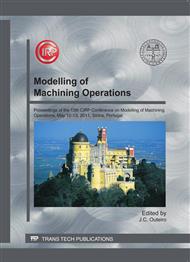p.411
p.421
p.431
p.439
p.449
p.456
p.464
p.473
p.483
Influence of Worn Tool on Polishability and Wear Resistance of VP20ISO Mold Steel
Abstract:
The aim of this study was to evaluate the influence of tool flank wear on polishability and wear resistance of mold steel. Two surfaces of Villares VP20ISO steel were machined, one was roughed with worn tools (VB>0.3 mm) and another one with new tools (0.05 mm<VB<0.1 mm), followed by the finishing process of both surfaces by machining with new tools. The surface residual stresses were then measured using the X-ray diffraction method. Surfaces were etched down to different depths in order to monitor the residual stresses in the total affected depth of workpiece deformed layer. The results show that the cutting and passive forces provided the major differences between two machining conditions. The micro-hardness in the cross section did not show significant differences. Moreover, the residual stress measurements showed that after the finishing process, the surface roughed with new tools exhibited 100 MPa compressive stresses at 35 mm below the surface, while the surface roughed with worn tools provided a valley of tensile stress from the surface. Tests conducted on a pin-on-disk tribometer showed that the wear rates of the surface roughed with new tools were lower than the one roughed with worn tools and, after the polishing process, that the surface finishing of the surface roughed with new tools was better.
Info:
Periodical:
Pages:
449-455
Citation:
Online since:
April 2011
Keywords:
Price:
Сopyright:
© 2011 Trans Tech Publications Ltd. All Rights Reserved
Share:
Citation:


